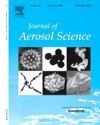Evaluation of bacterial and fungal load of different air conditioning systems in various operating conditions and quantitative microbial risk assessment
Abstract
Constant monitoring of indoor microbial contamination is crucial due to its direct impact on individuals' health through the inhalation of bioaerosols. This study assessed the bioaerosol content of outlet air from evaporative cooling systems (ECS) and air conditioning splits (ACS) at the Qom School of Health under various operating conditions. The microbial load (CFU m⁻³) was analyzed using the Andersen method, employing separate media cultures for bacteria and fungi. Fungal species and density were determined through staining with Lactophenol cotton blue and microscopic observation. The average fungal load in ECS outlet air (54.56 CFU m⁻³) significantly exceeded the bacterial load (20.30 CFU m⁻³) (p-value <0.01). Increased ECS fan speed correlated with a higher bacterial load, while high salinity and total dissolved solids (TDS) in ECS water reduced microbial growth. Changes to wetted screens increased the microbial load. Aspergillus versicolor and Aspergillus Niger were the prevalent fungal species in ECS, with higher fan speeds associated with increased fungal load. An elevation in ACS temperature significantly reduced the bacterial load in outlet air. Cladosporium and Aspergillus species dominated fungal density in ACS. A comparison between coolers indicated a higher bacterial load in ACS and a higher fungal load in ECS. Washing internal filters reduced the cumulative annual risk of disease according to quantitative microbial risk assessment (QMRA). Given the considerable time spent indoors, indoor contamination poses significant health risks, necessitating continuous monitoring of indoor microbial loads.

 求助内容:
求助内容: 应助结果提醒方式:
应助结果提醒方式:


